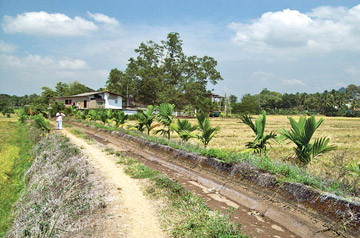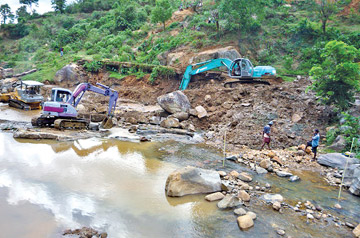|
More facilities under Mahinda Chinthana to top up
tanks:
Irrigation on an unprecedented scale
By P. Krishnaswamy
The Irrigation Department which is over 100-years-old has played a
significant role in harnessing water through the construction of a large
number of reservoirs and tanks to increase agricultural productivity
while also contributing to the economic and social welfare of farmers.
 |
|
Dredging uncleared
tanks |
By 2020, the irrigation sector will become a key-driving force in
agricultural development with the supply of water in adequate,
quantities and in a eco-friendly manner.
President Mahinda Rajapaksa when he came into power in 2005, gave
priority to making the country self-sufficient in rice and under the
'Mahinda Chintana' concept, has already achieved it. The Irrigation
Department and the Mahaveli Authority under his guidance have
contributed immensely towards achieving that goal. Export promotion
Zones are to be set up in Ampara, Hambantota, Polonnaruwa and Mannar for
promoting the export of rice and other food crops.
Minister of Irrigation and Water Resources Management, Nimal Siripala
de Silva told the media that the Irrigation Department is a responsible
and capable institution that has constantly achieved its targets despite
many challenges and many of the major reservoir projects under its
management. The Rs.6.7 billion Deduruoya Reservoir Project that will be
completed in March 2013 will bring 30,000 acres of arable land under
cultivation, benefiting over 50,000 farmers while also consolidating the
national plan of food security in the country, he said.
The water level and storage of 71 major reservoirs under its
management in the agricultural districts of Ampara, Anuradhapura,
Badulla, Batticaloa, Hambantota, Matara, Matale, Kurunegala, Monaragala,
Polannaruwa, Puttalama, Trincomalee, Vavuniya and Mannar have risen to
an average of 55 percent after experiencing rainfall in the catchment
areas during the recent monsoonal rains.
In the last decade high reservoir density helped water management
enabling storage of erratic rainfall, development of new water storage
and diversion facilities such as the Wehragala, Mau-Oya, Kekiriobanda
and Wemedilla diversions. Better water management strategies such as
change of stagger in the Kaltota scheme, reduction of land preparation
period to 3 weeks and adoption of 3 - 3 1/2 month rice varieties in Maha
have been adopted for increasing productivity.
The Dam Safety and Water Resources Planning Project (DSWRPP) is under
implementation for dam safety and operational efficiency improvement,
upgrading and modernizing of current Hydro-Meteorological Information
System (HMIS) and for Multi Sectoral Water Resources Planning. The total
cost of the DSWRP is US $ 71.66 million ( Rs.8187 Mn) of which IDA/World
Bank Credit is US$ 65.33 Mn (Rs.7586 Mn) and the Government of Sri Lanka
conribution is US $ 6.33 Mn (Rs.602 Mn). The objectives of the project
is to " improve the development and management of water resources within
the country, reduce water induced hazards to public, and enhance
effectiveness of water related investments". The Bowatenne, Polgolla,
Victoria, Randenigala, Rantambe, Kotmale, Kalwewa, Kandalama, Dambulu
Oya, Maduru Oya and Chandrikawewa under the Mahaveli Authority, the
Parakrama Samudraya, Menneriya, Giritale, Kaudula, Kantale, Nachchduwa,
Huruluwewa, Rajangana, Nuwarawewa, Tissawewa, Vendrasan, Ingnimitiyai ,
Ridiyagama, Tabbowa, Nalanda and Usgala-Siyambalangamuwa under the
Irrigation Department , Canyon, Castlereagh, Laxapana and Norton under
the Ceylon Electricity Board and the Kalatuwawa tank under the Water
Supply and Drainage Board have been selected and work is in progress on
these, with wok nearing completion in some of them.
 |
|
Some of the areas being
cultivated |
 |
|
Tank acreage being
increased to ensure irrigation throughout the year |
The Irrigation Department implemented several major multi-purpose
reservoir and irrigation projects from its inception, starting from the
massive Galoya Valley and Udawalawa Development Projects under the
government of Prime Minister D.S.Senanayake, followed by other projects
by successive governments including the Chandrika Wewa Project, Jayanthi
Wewa Project and the Lunugamwehara project (Kirindioya), Mahakanadarawa
and Rajangana projects. The Department also played its significant role
towards the massive Mahaveli Multi-purpose Development Project which
encompasses many parts of the country.
The Department already implemented several major projects under the '
Mahinda Chintana' concept that : " By 2020, the Irrigation Sector will
become the driving force in agriculture development with the supply of
water in adequate, equitable and reliable quantities and in a
sustainable, efficient and economic-friendly manner".
These development projects in the irrigation and agricultural sector
have been well studied, minutely planned and systematically implemented
to ensure biodiversity and sustainability , thanks to the vision of our
ancient rulers and President Rajapaksa, while water crisis, both for
consumption and food crop production, is looming large in many world
nations today. In many countries, water diversion from rivers has now
reached a point where some of them no longer make it to the sea. In
some, especially in the Middle East countries, exploitation of
below-surface water has been excessive and reckless, without regard for
what is sustainable and without any plans for replenishment.
Fortunately Sri Lanka is safeguarded in this respect. The future of
the irrigation sector has been set out in a way to promote agriculture
productivity by increasing the availability of new water resources and
enhancing the present level of waster use and conveyance efficiency to
an optimal level. Under the ' New Water Resources Development Program'
the already started large scale development programs will be expedited,
after resolving the technical and financial constraints over the medium
term. These include the Moragahakanda & Kaluganga Reservoirs Development
Projects, the Uma Oya Hydro Power Diversion Project and the Rambukkan
Oya Project. These reservoir projects will also replenish the
below-surface aquifers around the project-site areas. The total
investment requirement in the irrigation sector over the period from
2010 to 2020 is estimated at Rs.277.5 billion. Of this Rs.186.7 billion
is expected from foreign sources and the remainder will be financed by
the government with the support of the private sector.
The Government had allocated Rs.4.062 Billion in the 2012 Budget for
19 ongoing new irrigation projects.
The other ongoing projects will also provide infrastructure
facilities to local residents in addition to providing irrigation
facilities for the cultivation of paddy and other highland crops.
|



